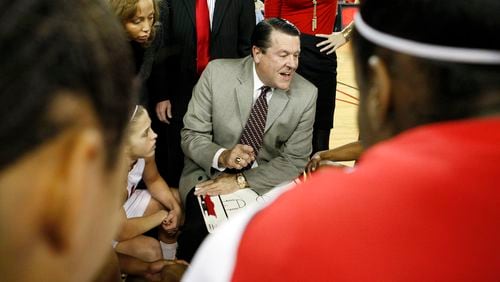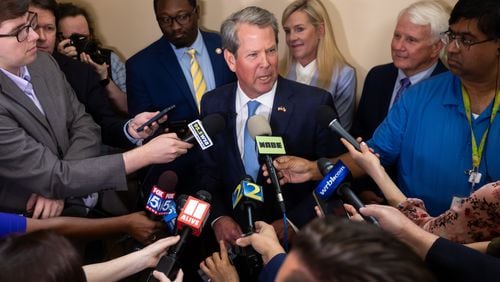While in Athens, former women’s basketball coach Andy Landers asserted Georgia’s place within the elites of college women’s basketball.
Landers, 71, posted an 866-299 record, won seven SEC championships and went to five Final Fours over his career. His final season was 2015.
Now, while enjoying retirement, Landers spends his time either with his family or at his farm in Watkinsville, marveling at the recent growth of the women’s college basketball that he helped to pioneer.
(This interview has been edited for clarity.)
Q. How have you been keeping busy since your retirement? I know you did some broadcasting, but what else have you done since then?
A. We did the broadcasting for (five or six) years. I have twin granddaughters, 3 years old, so that can be interesting. My dad is 98, and he lives in East Tennessee. I run back-and-forth up there, typically every two weeks and spend time with him and do things around the place up there that need to be done. And then I have a farm here in Watkinsville, 115 acres with about 60 head of cattle, so I piddle with that all the time when I’m not doing the other things.
Q. As far as today’s college basketball landscape, do you keep up with it?
A. I do, I follow it pretty closely, actually. I still communicate with the people at ESPN from time to time and have great relationships with those people. (I) still have a lot of friends that coach and talk to them a good bit. I watch, during the season. I watch it on television a lot and then also go to (Georgia’s) home games when I’m in town.
Q. What do you attribute the growth of women’s basketball to?
A. I think it can be traced to two teams, Connecticut and Tennessee. Probably around 2000, Connecticut had great teams, and ESPN started televising a lot of their games. So why did they do that? I’ve thought about it a lot, having worked in Bristol and driven from Bristol (home of ESPN) to Storrs, Connecticut (University of Connecticut). It was easy. You got the best team in the country in your state an hour away. If you’re going to televise any women’s basketball, I mean that’s just too easy. ... So then, ESPN started doing some Tennessee games. Now what was golden was Tennessee versus Connecticut. … We actually adjusted the Southeastern Conference schedule so Tennessee could play Connecticut in February.
Q. What about the current state of the game?
A. All the games are being televised. What is cool about it is, at a time when you’re getting all this visibility for the first time, you have a star. And she captivates. Whether you’re a women’s basketball fan or not, you tune in to watch Caitlin Clark. All of a sudden, you can be a Caitlin Clark fan for a lot of reasons. She’s just a terrific ambassador for the sport.
There’re people walking in my neighborhood the other day, and they stopped and talked, and all of a sudden they said, “Oh, we got to go. The game is about to come on.” And they’re 80 years old. And it was the Iowa game that they were talking about. They wanted to see Caitlin Clark.
Q. When you were coaching, did you foresee that (college women’s basketball) would get this big?
A. Yeah, I did. My guiding light in thinking that it would be popular, that it would get popular, was men’s basketball. Men’s basketball wasn’t always like it is now. I can remember when I was in high school, SEC men’s basketball wasn’t a big deal. It just wasn’t. So, I kind of went back in time and I looked at (where) men’s basketball started. And at this point in its development, it was here, and then you could see it climb. You could see the ascent that it had, and I said that’s probably going to be women’s basketball.
It’s rare when something new or different is introduced, and it zooms straight to the top. It happens with products, but it’s rare. I always felt like it would probably take this much time, but if we didn’t work really hard, it would have taken longer.
Q. You mentioned how you coached through the changes and lived through them. What were some of the challenges that the increased television and exposure brought?
A. The challenge for me was always the same, and that was to be the best. So obviously, we embraced any opportunity associated with any kind of exposure. We wanted that because we wanted people to see how good we were. I don’t think television challenged us. The challenge was to get that exposure.
Q. So, how did you go about getting that exposure (for Georgia)?
A. We literally worked it. I drove to Gwinnett County. I drove to Atlanta to those little mom-and-pop cable networks and begged them. We would do things like invite the Atlanta sports department over to have a little fun scrimmage against our team, so they’d know how good our team was.
Q. It sounds like you put a lot of emphasis into getting that market and that exposure for women’s basketball. How much time do you think you spent on that?
A. I would say somewhere around 15% of my time, which is a lot because probably 50% of my time was recruiting, and then the rest of it was just with the team. I had to ask Mike Mobley or whoever my SID was and see if you could get a lot of Macon newspapers, see if you can get a hold of Macon television stations, see if you can get them up here for the game.
And this was where you rolled the dice a little bit, especially if you weren’t good. We were fortunate we were always good, most of the time better than good. But the real key was scheduling a game – I always went out and tried to schedule a game or two or three games that would work for television in hopes that they would pick those games up and televise them. We regularly played Stanford. We had two different series with Oklahoma. We played Texas a number of times. We played North Carolina. You name it because if there’s only going to be two games on ESPN this year, it’s not going to be Georgia and Mercer. So, we always tried to play a game that we hoped would be attractive, and oftentimes it was.
Q. What other benefits do you think scheduling tougher, more appealing opponents brought to the team?
A. I think it solidified who we thought we were. I think it solidified and elevated our program. I think there was a period of time, maybe 20 years, where if you ask people who the top five programs in the country (were), Georgia probably would have been mentioned by most people you ask. The only way people can believe that is if you’ve beaten (a good team).
It actually became a thing that our kids really didn’t want to play in the easy games. They wanted the competitive games. They wanted the games that have had a different level of meaning, not just to them but to women’s basketball.
Q. You never had a losing season in your career. What was the key to maintaining this level of consistency, especially with the level of opponents your teams played?
A. It probably started with our coaching staff. We were the same every day. It didn’t matter if we had … five freshmen starting or five seniors starting. We’re going to come to work every day. We’re going to work harder than anybody in the country. We’re going to believe in what we do. We made important things important. We didn’t mess with a lot of things that weren’t important. You don’t have to be the best to be the best. The best gets beaten all the time. We understood that, but we also understood that recruiting was important. Having good players was really important. The better the players, the better we were going to be typically. We worked really hard at that from a recruiting standpoint.
Q. What was your recruiting philosophy?
A. I always felt that I needed to be able to connect. We walked away from great players. If it didn’t feel right, if there wasn’t a certain level of respect in the room when we met, then we didn’t hang around. I think that’s important in recruiting. There needs to be a connection. We felt like there had to be a connection. Everybody says this, but I’m telling you, we walked away from some great players who I didn’t think were good kids.
Q. You discussed your players and how you like to connect with them. Katie Abrahamson-Henderson mentioned the other day that you still keep in touch, so how do you approach players once they leave the program?
A. It’s interesting, I’ve talked to two today. One of them played in the ‘80s, and the other one played around 2000. I texted one last night that played in 1996. We formed that bond of competition, of hard work, of sacrifice, of caring about each other, and that still exists. We’re not coach and player anymore, we’re just friends. It can be the stupidest phone call in the world. It can be laugh from beginning to end or it can be, ‘Hey, my mom is in the hospital, just thought I’d let you know.’ I might call her mom.
Q. You’re known for coaching your players tough, so how were you able to establish that tough coaching while also letting them know you are there for them as a coach and as a friend?
A. If they know you care, and I’m not talking about if they heard you say you care, they have to know you care. I think almost all of our kids realized during the recruiting process that I was different, that they could trust me and that I cared about them. Once they know you care, they trust you.
Q. To conclude, I’m just going to open the floor if there’s anything else you wanted to mention about the future of college women’s basketball or your time at Georgia.
A. I think the thing that really helped it this year, no question about it, was Caitlin Clark. There might be a little bit of an adjustment downward without a Caitlin Clark, but anytime there’s a great player in the game of basketball, it has a positive effect. So hopefully, we keep those great players coming on. I told my wife the other day, ‘You know what will be interesting to me? 10 years from now, I want to see what kind of effect Caitlin Clark had on little 6-year-old girls. I want to see if they pick up a basketball. It wouldn’t surprise me if 10-12 years from now, there’s three or four Caitlin Clark’s because she showed little girls what they can do.
Olivia Sayer is a student in the Sports Media Certificate program at the University of Georgia’s Carmical Sports Media Institute.






